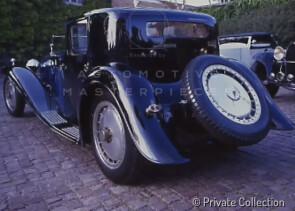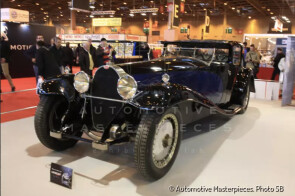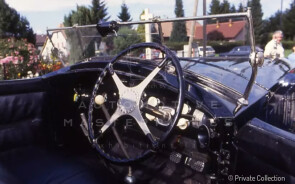
1929 Bugatti Type 41 Royale Coupé Napoleon
ON/OFF
Why am I an Automotive Masterpiece?
L. Limited edition cars
no. 7 manufactured, no. 6 remaining
The Type 41 Royale was Ettore Bugatti's most luxurious and extreme car. It was designed for heads of state and massive chauffeur-driven bodies. Thus, it was the largest Bugatti both in length and engine displacement. Ettore Bugatti planned to build twenty-five of these cars, sell them to royalty and to be the most luxurious and expensive car ever made. But even European royalty was not buying such things during the Great Depression, and Bugatti was able to sell only three of the six made. Ironically none of the Royale's owners were royals and to this date none of the six Type 41s has ever been owned by a royal. All six production Royales still exist (the prototype was destroyed in an accident in 1931), and each has a different body, some having been rebodied several times. All Royales were individually bodied. The radiator cap was a posed elephant, a sculpture by Ettore's brother Rembrandt Bugatti. For Ettore Bugatti, the Royale was to be the pinnacle, a world-beater in terms of power, quality and reputation.
Of the six official Royale, the Coupé Napoléon was the first in numerical order of chassis, but not the first in chronological order: this oddity is explained by the fact that its origin is closely linked to the original long wheelbase prototype. This prototype already bore the chassis number 41.100. Then came the 1931 accident with Ettore Bugatti falling asleep: at that point, the serial number of the original chassis was reused to build a new one that would be bodied as a Coupé Napoléon. However, this chassis did not have the same characteristics as the original prototype chassis, but those typical of the other Type 41s which in the meantime were assembled with the dropper, that is, with a wheelbase of 4.318 meters and a 12.8-liter engine, in addition to the slightly reduced track widths. For this reason, according to some historians, even the prototype is to be considered as part of the production, while other historians are of the opposite opinion. The Napoleon Coupé is in fact a De Ville coupé with two-tone black and blue bodywork, with a glass roof and a blue velvet interior, which at the time was more valuable than the leather upholstery. The body was designed by Jean Bugatti, son of Ettore, when he was only 20. The harmonious overall design, with its clear lines and curves, somehow seems to mask the unusually large size of the car. For many years it was the private car of Ettore Bugatti himself, having failed to sell it to anyone. At the outbreak of the Second World War, the Coupé Napoléon was walled up together with two other unsold specimens (the Berline de Voyage and the coach Kellner) inside the castle of Ermenonville, at the time the home of the Bugatti family, so that it would not be found and requisitioned by the Nazis. The car came back to life at the end of the conflict, again in the hands of Ettore Bugatti. Today the same car can be found in the Cité de l'Automobile in Mulhouse, France after being part of the Schlumpf brothers' collection.




